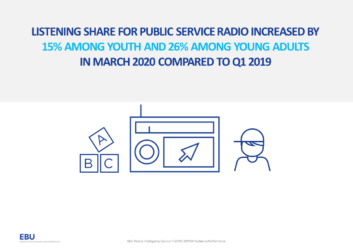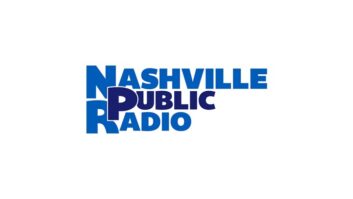 The author of this commentary is manager of the EBU’s Media Intelligence Service.
The author of this commentary is manager of the EBU’s Media Intelligence Service.
The COVID-19 pandemic has been devastating across the world, but it has also brought out the best from many people and institutions. This is also what we have observed at the European Broadcasting Union (EBU), with our public service radio members transforming their working procedures and their output radically to serve their fellow citizens.
The responsiveness of public service radio during this crisis and the way citizens have turned to it in search of trusted news shows that radio at the service of the public is part of the essential infrastructure of any modern society. Any infrastructure requires the major use of technologies, and this has also been the case for radio.
SUPPORTING CITIZENS AS A PRIORITY
In tough times, citizens have been able to experience anew how public radio plays a vital role in society. Initially, this meant providing and curating trustworthy information to deal with the uncertainties of a completely new situation for most citizens. But this role quickly expanded to encourage people to stay at home and keep safe in many creative ways.

Staying at home also meant a completely new situation for citizens but also for broadcasters. And based on its abilities, radio found new missions, namely providing release during the lockdown, supporting a sense of community by bringing people together, supporting citizens in need and encouraging solidarity, supporting kids and parents at home through special educational and entertainment programs, providing emotional support in an spiral of negativity, and giving voice to citizens’ experiences, creating a common arena and documenting the state of the nation.
Examples abound. Classical music station France Musique made a very creative use of technology by organizing three participatory living room concerts with 600 amateur musicians and 46 members of the Orchestre National de France playing the famous Waltz No. 2 by Dmitri Shostakovich and demonstrating that music was alive during lockdown. In Viva l’Orchestra à la maison (Viva the orchestra at home!), videos showing the musicians joining from their homes were published online as well as on social media, with amateurs invited to send in video recordings of how they played at home. Professionals from the national orchestra instructed the amateurs through video tutorials. In fact, video has become a key tool during this period, adding to audio on public radio’s platforms but also on social media platforms which have been heavily used during this period.
Generally speaking, public radio stations have been more open to participation from the audience, including not only videos but also voicemail or via the broadcasters’ apps. In Belgium, VRT honored the heroes of COVID everyday life such as nurses, bus drivers or supermarket cashiers. During the campaign Helden van de dag (Heroes of the day), VRT’s Radio 2 received more than 1,000 messages a day through its app from listeners wishing to celebrate their baker or postman.
SUPPORTING CULTURE AND ARTISTS ALSO A PRIORITY
A big part of this support to citizens included bringing arts and culture direct to their homes, as all cultural venues were closed. This also had the beneficial effect of supporting the much-needed cultural sector, heavily affected by the lockdowns.
To support artists and the creative sector, public radio increased their exposure in their broadcasts, for instance by increasing the rotation of national musicians, including many newcomers and less well-known artists, or creating dedicated online events. In the Netherlands, for instance, NPO Radio 2 organized two online festivals aiming to promote freelance artists from the Dutch music scene by giving them a free platform and technical support, e.g. by setting up audio and video livestreams to air their music. The sessions were broadcast live on visual radio.
[Related: “EBU Members Work to Ensure News Continuity”]
As a logical next step, they also stepped in for cancelled cultural events, including not only music, strongly associated to radio, but also theater, cinema, literature, or performing arts. For example, BBC launched its Culture in Quarantine virtual festival of the arts by creating a dedicated platform for British culture. This cross-platform initiative features most intensively across BBC Radio 3, BBC Radio 4, TV channels BBC Two and BBC Four, and digital platforms BBC Sounds and BBC iPlayer.
In cooperation with Arts Council England, the platform includes performances, guides to shuttered exhibitions, quarantine diaries from creative visionaries, but also advice on how audiences can themselves be creative at home or readings from fictional and non-fictional books.
Supporting creators in need was also a shared goal, by launching and accelerating new commissioning processes or, in general, supporting audio creators.
Finally, public radio stations have also provided a forum for artists and their experiences, for instance by kickstarting the discussions about the aftermath with different cultural parties.
RECONSIDERING PRODUCTION TECHNOLOGIES
All this fantastic output has been produced in many cases by journalists, producers and technicians that did not have access to their stations’ facilities. The use of everyday technology, usually thought not to have the required quality, was considered good enough in these highly atypical circumstances. The value of their flexibility increased in harsh conditions and made some organizations move further in their digital transformation in a few weeks than in the last few years.
With many broadcasters already back in their facilities, it will be interesting to see how much of those reactive crisis management processes consolidate in the long term. Beyond the technical possibilities, the crisis may have impacted more deeply on the culture regarding technology within radio stations. Time will tell.
The above insights come from a report recently published by the EBU on Public Radio Response to the Pandemic.
Comment on this or any article by emailing [email protected] with “Letter to the Editor” in the subject line.
[Related: “On Its 70th Anniversary, EBU Maintains Initial Vision”]







